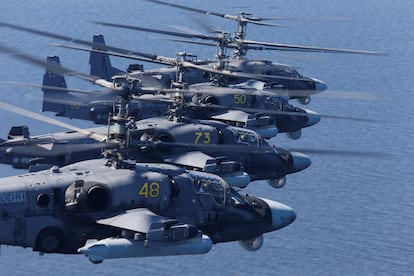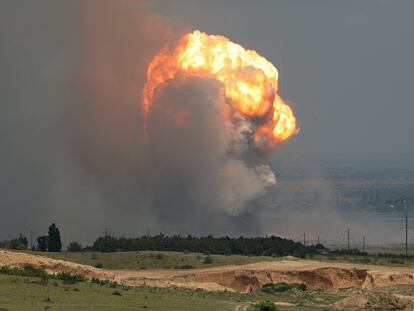Ka-52 Alligator: The Russian helicopter slowing Ukraine’s counteroffensive in the south
The latest model of the attack aircraft, which has been deployed amid heavy fighting in the Zaporizhzhia region, has been upgraded with weapons capable of evading anti-missile defenses

In flat terrain like that of southern and eastern Ukraine, amid trench warfare where advances are counted by the meter, control of the air has become crucial and Russia now has a key weapon, the Ka-52 Alligator attack helicopter. Previously deployed in the Syrian war, Moscow has modified it to incorporate improvements suggested by its forces fighting in that conflict and has adapted the aircraft for its operations within the territories occupied by Russia in the wake of the invasion launched in February 2022. Among these upgrades is a missile with a range of up to 15,000 meters, which is capable of evading Ukrainian anti-aircraft defenses.
The UK Ministry of Defense considers the Ka-52 to be “one of the most influential Russian weapons systems” to counter the Ukrainian counteroffensive in the south of the country. Kyiv’s forces have recently stepped up their agonizing advance with Western-trained troops equipped with German-made Leopard tanks and U.S. Bradley armored vehicles. Both the U.S. Defense Department and the Kremlin have acknowledged the increased intensity of Kyiv’s attacks, which led to Ukrainian troops temporarily breaking through Russian defenses in the town of Robotyne last Friday. Kyiv’s objective is to open a breach in the corridor linking the occupied east with the south and Crimea in order to reach the shores of the Sea of Azov, which remains under Moscow’s control.
It is in that scenario that the Ka-52 helicopter may provide the key for Moscow to halt, or at least slow down, the Ukrainian push in Zaporizhzhia. The Ka-52 has been in service with the Russian Air Force since 2010 and its coaxial rotor — made up of two propellers that rotate in different directions — provides it with “unique maneuverability to perform combat maneuvers in a small amount of airspace to occupy a favorable attacking position in the shortest possible time,” according to its manufacturer. Its maximum speed is 350 kilometers per hour (217 mph) and it has an operational ceiling of 5,500 meters and a range of over 500 kilometers (310 miles).
The Ka-52 is a two-seater armored aircraft in which the pilots sit side by side, and the first operational helicopter in the world to feature an ejection system. It can operate day and night and in all weather conditions thanks to its sensors. In its basic variant, it has a 30-millimeter cannon on its right side and under its wings it can carry various combinations of weapons including anti-tank missiles, air-to-air missiles, unguided rockets, and bombs of differing calibers. In combat missions, it can deploy up to 12 Vikhr air-to-surface missiles with a range of up to eight kilometers to destroy enemy tanks.
“These are devices that can fly very low, between 50 and 100 meters, which makes them practically undetectable for the Ukrainians,” says analyst Guillermo Pulido of Ejércitos magazine. “Given Russia’s air superiority, Ukraine cannot shoot them down with its aircraft or its low-level anti-aircraft defenses; moreover, [Kyiv’s] combat helicopters are much more rudimentary,” adds the specialist, who adds that some Ka-52 models are equipped with devices to deflect missiles launched against them. “The Ka-52 is, in principle, practically immune to any weapon the Ukrainians might employ against it; it can fire rockets from much longer distances than the Stinger anti-aircraft missiles the Ukrainians have, so it is feasible that it would be a good weapon to stop the counteroffensive.”
However, since the Russian invasion of Ukraine was launched in February 2022, Moscow has lost about 40 such aircraft. At the same time, these helicopters, according to British intelligence, have wreaked a heavy cost on Ukrainian forces in terms of casualties and material damage. In recent months Moscow has deployed a new model, the Ka-52M, developed after the Syrian war, according to the British Ministry of Defense, which incorporates improvements suggested by the Russian Air Force during that campaign.
These upgrades included incorporating the Izdeliye 305 cruise missile, which was used in combat for the first time in Syria, albeit mounted on another attack helicopter, the Mi-28. For this purpose, the new models were equipped with a specific interface for this type of rocket, a launcher, and a radio link to be able to guide it. Its performance was also enhanced “with a 360º vision system, the latest data exchange systems and satellite navigation equipment,” according to the TASS news agency.
The Izdeliye 305E has almost double the range of the Vikhr missile, at around 15 kilometers, and a much greater operational and destructive capability. In addition to its range, it carries a 25-kilogram warhead, three times larger than that of the previous rockets deployed on the Ka-52. These can be guided by optical or thermal devices and their trajectory can be modified in mid-flight via satellite, allowing the attack helicopter to immediately separate from the launch site, even without having previously set a target. A Stinger portable anti-aircraft missile such as those provided to Kyiv by the U.S. has a maximum range of about six kilometers.
Given the superiority of the Ka-52, Ukrainian intelligence services must play a central role, according to the experts consulted. The autonomy of these aircraft is very limited and it is possible, with current technological means, to learn in advance which base they will depart from to carry out operations, and the trajectory they will follow until they have their targets within range. Experts also point to the possibility of using electronic warfare devices capable of deflecting the new missiles these helicopters carry.
“Ka-52 crews have been quick to seize opportunities to try to launch such devices beyond the range of Ukrainian air defenses,” stated a British intelligence report last Thursday. It now remains to be seen whether the weaponry provided by the western allies to Kyiv is enough to keep its army pushing southward despite the theoretical superiority that, according to the UK, the Ka-52 can provide Moscow to slow the counteroffensive.
Sign up for our weekly newsletter to get more English-language news coverage from EL PAÍS USA Edition
Tu suscripción se está usando en otro dispositivo
¿Quieres añadir otro usuario a tu suscripción?
Si continúas leyendo en este dispositivo, no se podrá leer en el otro.
FlechaTu suscripción se está usando en otro dispositivo y solo puedes acceder a EL PAÍS desde un dispositivo a la vez.
Si quieres compartir tu cuenta, cambia tu suscripción a la modalidad Premium, así podrás añadir otro usuario. Cada uno accederá con su propia cuenta de email, lo que os permitirá personalizar vuestra experiencia en EL PAÍS.
¿Tienes una suscripción de empresa? Accede aquí para contratar más cuentas.
En el caso de no saber quién está usando tu cuenta, te recomendamos cambiar tu contraseña aquí.
Si decides continuar compartiendo tu cuenta, este mensaje se mostrará en tu dispositivo y en el de la otra persona que está usando tu cuenta de forma indefinida, afectando a tu experiencia de lectura. Puedes consultar aquí los términos y condiciones de la suscripción digital.
More information
Archived In
Últimas noticias
Welcome to the post-religion era: The idea of Christianity as the absolute truth has become obsolete
‘I thought you would like it’: The risky sexual practice popularized by TV shows and TikTok
The digitalization of tourism: ‘They promise experiences and gave us the worst possible one’
Mexican peso defies uncertainty with forecasts of a new period of stability in 2026
Most viewed
- Sinaloa Cartel war is taking its toll on Los Chapitos
- Oona Chaplin: ‘I told James Cameron that I was living in a treehouse and starting a permaculture project with a friend’
- Reinhard Genzel, Nobel laureate in physics: ‘One-minute videos will never give you the truth’
- Why the price of coffee has skyrocketed: from Brazilian plantations to specialty coffee houses
- Silver prices are going crazy: This is what’s fueling the rally









































